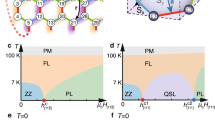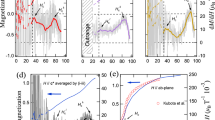Abstract
α-RuCl3 is drawing much attention as a promising candidate for the Kitaev quantum spin liquid1,2,3,4,5,6,7,8. However, despite intensive research efforts, controversy remains about the form of the basic interactions governing the physics of this material. Even the sign of the Kitaev interaction (the bond-dependent anisotropic interaction responsible for Kitaev physics) is still under debate, with conflicting results from theoretical and experimental studies5,6,9,10,11,12,13,14,15. The significance of the symmetric off-diagonal exchange interaction (referred to as the Γ term) is another contentious question16,17,18. Here, we present resonant elastic X-ray scattering data that provide unambiguous experimental constraints to the two leading terms in the magnetic interaction Hamiltonian. We show that the Kitaev interaction (K) is ferromagnetic, and that the Γ term is antiferromagnetic and comparable in size to the Kitaev interaction. Our findings also provide a natural explanation for the large anisotropy of the magnetic susceptibility in α-RuCl3 as arising from the large Γ term. We therefore provide a crucial foundation for understanding the interactions underpinning the exotic magnetic behaviours observed in α-RuCl3.
This is a preview of subscription content, access via your institution
Access options
Access Nature and 54 other Nature Portfolio journals
Get Nature+, our best-value online-access subscription
$29.99 / 30 days
cancel any time
Subscribe to this journal
Receive 12 print issues and online access
$209.00 per year
only $17.42 per issue
Buy this article
- Purchase on Springer Link
- Instant access to full article PDF
Prices may be subject to local taxes which are calculated during checkout



Similar content being viewed by others
Data availability
All data that support the plots within this paper and other findings of this study are available from the corresponding author upon reasonable request.
Code availability
The computer code used to generate results that are reported in the paper is available from the authors on reasonable request.
References
Plumb, K. W. et al. α-RuCl3: a spin-orbit assisted Mott insulator on a honeycomb lattice. Phys. Rev. B 90, 041112(R) (2014).
Sears, J. A. et al. Magnetic order in α-RuCl3: a honeycomb-lattice quantum magnet with strong spin-orbit coupling. Phys. Rev. B 91, 144420 (2015).
Sandilands, L. J., Tian, Y., Plumb, K. W., Kim, Y.-J. & Burch, K. S. Scattering continuum and possible fractionalized excitations in α-RuCl3. Phys. Rev. Lett. 114, 147201 (2015).
Johnson, R. D. et al. Monoclinic crystal structure of α-RuCl3 and the zigzag antiferromagnetic ground state. Phys. Rev. B 92, 235119 (2015).
Banerjee, A. et al. Proximate Kitaev quantum spin liquid behaviour in a honeycomb magnet. Nat. Mater. 15, 733–740 (2016).
Banerjee, A. et al. Neutron scattering in the proximate quantum spin liquid α-RuCl3. Science 356, 1055–1059 (2017).
Do, S.-H. et al. Majorana fermions in the Kitaev quantum spin system α-RuCl3. Nat. Phys. 13, 1079–1084 (2017).
Kasahara, Y. et al. Majorana quantization and half-integer thermal quantum Hall effect in a Kitaev spin liquid. Nature 559, 227–231 (2018).
Kim, H.-S., Shankar, V. V., Catuneanu, A. & Kee, H.-Y. Kitaev magnetism in honeycomb RuCl3 with intermediate spin-orbit coupling. Phys. Rev. B 91, 241110(R) (2015).
Kim, H.-S. & Kee, H.-Y. Crystal structure and magnetism in α-RuCl3: an ab initio study. Phys. Rev. B 93, 155143 (2016).
Winter, S. M., Li, Y., Jeschke, H. O. & Valentí, R. Challenges in design of Kitaev materials: magnetic interactions from competing energy scales. Phys. Rev. B 93, 214431 (2016).
Yadav, R. et al. Kitaev exchange and field-induced quantum spin-liquid states in honeycomb α-RuCl3. Sci. Rep. 6, 37925 (2016).
Hou, Y. S., Xiang, H. J. & Gong, X. G. Unveiling magnetic interactions of ruthenium trichloride via constraining direction of orbital moments: potential routes to realize a quantum spin liquid. Phys. Rev. B 96, 054410 (2017).
Wang, W., Dong, Z.-Y., Yu, S.-L. & Li, J.-X. Theoretical investigation of magnetic dynamics in α-RuCl3. Phys. Rev. B 96, 115103 (2017).
Eichstaedt, C. et al. Deriving models for the Kitaev spin-liquid candidate material α-RuCl3 from first principles. Phys. Rev. B 100, 075110 (2019).
Rau, J. G., Lee, E. K.-H. & Kee, H.-Y. Generic spin model for the honeycomb iridates beyond the Kitaev limit. Phys. Rev. Lett. 112, 077204 (2014).
Katukuri, V. M. et al. Kitaev interactions between j = 1/2 moments in honeycomb Na2IrO3 are large and ferromagnetic: insights from ab initio quantum chemistry calculations. New J. Phys. 16, 013056 (2014).
Chaloupka, J. & Khaliullin, G. Hidden symmetries of the extended Kitaev-Heisenberg model: implications for the honeycomb-lattice iridates A2IrO3. Phys. Rev. B 92, 024413 (2015).
Kitaev, A. Anyons in an exactly solved model and beyond. Ann. Phys. 321, 2–111 (2006).
Jackeli, G. & Khaliullin, G. Mott insulators in the strong spin-orbit coupling limit: from Heisenberg to a quantum compass and Kitaev models. Phys. Rev. Lett. 102, 017205 (2009).
Yamaji, Y., Nomura, Y., Kurita, M., Arita, R. & Imada, M. First-principles study of the honeycomb-lattice iridates Na2IrO3 in the presence of strong spin-orbit interaction and electron correlations. Phys. Rev. Lett. 113, 107201 (2014).
Janssen, L., Andrade, E. C. & Vojta, M. Magnetization processes of zigzag states on the honeycomb lattice: identifying spin models for α-RuCl3 and Na2IrO3. Phys. Rev. B 96, 064430 (2017).
Modic, K. A. et al. Resonant torsion magnetometry in anisotropic quantum materials. Nat. Commun. 9, 3975 (2018).
Modic, K. A., Ramshaw, B. J., Shekhter, A. & Varma, C. M. Chiral spin order in some purported Kitaev spin-liquid compounds. Phys. Rev. B 98, 205110 (2018).
Riedl, K., Li, Y., Winter, S. M. & Valentí, R. Sawtooth torque in anisotropic j eff = 1/2 magnets: application to α-RuCl3. Phys. Rev. Lett. 122, 197202 (2019).
Koitzsch, A. et al. Low temperature enhancement of ferromagnetic Kitaev correlations in α-RuCl3. Preprint at https://arxiv.org/abs/1709.02712v1 (2017).
Ran, K. et al. Spin-wave excitations evidencing the Kitaev interaction in single crystalline α-RuCl3. Phys. Rev. Lett. 118, 107203 (2017).
Winter, S. M. et al. Breakdown of magnons in a strongly spin-orbital coupled magnet. Nat. Commun. 8, 1152 (2017).
Winter, S. M. et al. Probing α-RuCl3 beyond magnetic order: effects of temperature and magnetic field. Phys. Rev. Lett. 120, 077203 (2018).
Chaloupka, J. & Khaliullin, G. Magnetic anisotropy in the Kitaev model systems Na2IrO3 and RuCl3. Phys. Rev. B 94, 064435 (2016).
Cao, H. B. et al. Low-temperature crystal and magnetic structure of α-RuCl3. Phys. Rev. B 93, 134423 (2016).
Hill, J. P. & McMorrow, D. F. Resonant exchange scattering: polarization dependence and correlation functions. Acta Crystallogr. A 52, 236–244 (1996).
Moretti Sala, M., Boseggia, S., McMorrow, D. F. & Monaco, G. Resonant x-ray scattering and the j eff = 1⁄2 electronic ground state in iridate perovskites. Phys. Rev. Lett. 112, 026403 (2014).
Chun, S. H. et al. Direct evidence for dominant bond-directional interactions in a honeycomb lattice iridate Na2IrO3. Nat. Phys. 11, 462–466 (2015).
Kubota, Y. et al. Successive magnetic phase transitions in α-RuCl3: XY-like frustrated magnet on the honeycomb lattice. Phys. Rev. B 91, 094422 (2015).
Majumder, M. et al. Anisotropic Ru3+ 4d 5 magnetism in the α-RuCl3 honeycomb system: susceptibility, specific heat, and zero-field NMR. Phys. Rev. B 91, 180401(R) (2015).
Agrestini, S. et al. Electronically highly cubic conditions for Ru in α-RuCl3. Phys. Rev. B 96, 161107(R) (2017).
Lampen-Kelley, P. et al. Anisotropic susceptibilities in the honeycomb Kitaev system α-RuCl3. Phys. Rev. B 98, 100403(R) (2018).
Gohlke, M., Wachtel, G., Yamaji, Y., Pollmann, F. & Kim, Y.-B. Quantum spin liquid signatures in Kitaev-like frustrated magnets. Phys. Rev. B 97, 075126 (2018).
Momma, K. & Izumi, F. VESTA 3 for three-dimensional visualization of crystal, volumetric and morphology data. J. Appl. Crystallogr. 44, 1272–1276 (2011).
Strempfer, J. et al. Resonant scattering and diffraction beamline P09 at PETRA III. J. Synchrotron Rad. 20, 541–549 (2013).
Sears, J. A., Zhao, Y., Xu, Z., Lynn, J. W. & Kim, Y.-J. Phase diagram of α-RuCl3 in an in-plane magnetic field. Phys. Rev. B 95, 180411(R) (2017).
Brückel, T. et al. Antiferromagnetic order and phase transitions in GdS as studied with X-ray resonance-exchange scattering. Eur. Phys. J. B 19, 475–490 (2001).
Acknowledgements
We would like to thank J. Bertinshaw and H. Suzuki for their help with the experiment. We acknowledge DESY (Hamburg, Germany), a member of the Helmholtz Association HGF, for the provision of experimental facilities. Parts of this research were carried out at PETRA III. Work at the University of Toronto was supported by the Natural Science and Engineering Research Council (NSERC) of Canada, Canadian Foundation for Innovation, Ontario Innovation Trust, and the Center for Quantum Materials at the University of Toronto. Y.B.K. is also supported by the Killam Research Fellowship from the Canada Council for the Arts. This work was performed in part at Aspen Center for Physics, which is supported by National Science Foundation grant PHY-1607611.
Author information
Authors and Affiliations
Contributions
J.A.S. and Y.-J.K. conceived the experiments. J.A.S., P.J.B. and S.F. performed the experiments and J.A.S. analysed the data. J.A.S. synthesized and characterized the sample. S.K. provided the magnetic susceptibility data. L.E.C. and Y.B.K. performed theoretical calculations. J.A.S. and Y.-J.K. wrote the paper with contributions from all co-authors.
Corresponding author
Ethics declarations
Competing interests
The authors declare no competing interests.
Additional information
Publisher’s note Springer Nature remains neutral with regard to jurisdictional claims in published maps and institutional affiliations.
Supplementary information
Supplementary Information
Supplementary Figs. 1 and 2, and discussion.
Rights and permissions
About this article
Cite this article
Sears, J.A., Chern, L.E., Kim, S. et al. Ferromagnetic Kitaev interaction and the origin of large magnetic anisotropy in α-RuCl3. Nat. Phys. 16, 837–840 (2020). https://doi.org/10.1038/s41567-020-0874-0
Received:
Accepted:
Published:
Issue Date:
DOI: https://doi.org/10.1038/s41567-020-0874-0
This article is cited by
-
Possible intermediate quantum spin liquid phase in α-RuCl3 under high magnetic fields up to 100 T
Nature Communications (2023)
-
A magnetic continuum in the cobalt-based honeycomb magnet BaCo2(AsO4)2
Nature Materials (2023)
-
Magnetic anisotropy, exchange coupling and Dzyaloshinskii—Moriya interaction of two-dimensional magnets
Frontiers of Physics (2023)
-
Continuous manipulation of magnetic anisotropy in a van der Waals ferromagnet via electrical gating
Nature Electronics (2022)
-
Magneto-optical study of metamagnetic transitions in the antiferromagnetic phase of α-RuCl3
npj Quantum Materials (2022)



